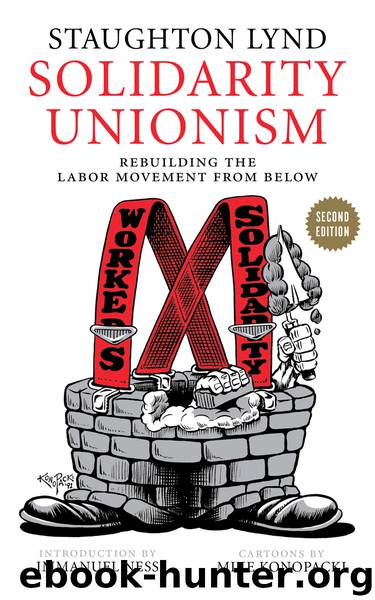Solidarity Unionism by Lynd Staughton; Ness Immanuel; Konopacki Mike

Author:Lynd, Staughton; Ness, Immanuel; Konopacki, Mike
Language: eng
Format: epub
Publisher: PM Press
Published: 2015-03-14T16:00:00+00:00
CIO CONTRACTUALISM
CIO unions were from the outset committed to contractualism, that is, to the regulation of relations between employer and employee by means of a legally binding collective bargaining agreement that (a) forbids strikes for the duration of the contract, and (b) cedes management decisions to the employer. The very first contracts between General Motors and the UAW, and between United States Steel and the Steel Workers Organizing Committee, in the spring of 1937, contained clauses prohibiting strikes for the duration of the contract. There was never a time when the leaders of CIO unions opposed such language. Indeed, they presented themselves to management as guarantors of labor peace.
Similarly, the “management prerogatives clause” typical in CIO contracts today was part of the very first collective bargaining agreement with U.S. Steel in 1937. Then the clause stated: “The management of the works and the direction of the working forces, including the right to hire, suspend or discharge for proper cause, or transfer, and the right to relieve employees from duty because of lack of work or for other legitimate reasons, is vested exclusively in the Corporation.”
Essentially the same words appear in the present U.S. Steel contract: “The Company retains the exclusive rights to manage the business and plants and to direct the working forces…. The rights to manage the business and plants and to direct the working forces include the rights to hire, suspend or discharge for proper cause, or transfer, and the right to relieve employees from duty because of lack of work or for other legitimate reason.”
There was an intimate connection between government sponsorship of CIO organization, and the fact that CIO unions from the beginning negotiated contracts containing no-strike and management prerogative clauses. The preamble to the Wagner Act identified its principal object as labor peace. CIO leaders acted the part they knew to be expected from them if they were to receive ongoing support from the government. Radical labor journalist Len DeCaux wrote in April 1935 that when Lewis and other union officials testified before the Senate committee considering the Wagner Act, the labor leaders said in effect: “Allow the workers to organize, establish strong governmental machinery for dealing with labor questions, and industrial peace will result.”
Download
This site does not store any files on its server. We only index and link to content provided by other sites. Please contact the content providers to delete copyright contents if any and email us, we'll remove relevant links or contents immediately.
Harvest Gypsies: On the Road to the Grapes of Wrath by Steinbeck John(674)
The History of Work by Richard Donkin(652)
Murder in the Garment District by David Witwer(608)
Pre-Accident Investigations by Todd Conklin(607)
1848 by Mike Rapport(599)
2030 by Albert Brooks(570)
A World Without Work by Daniel Susskind(566)
A Life in Error by James Reason(549)
Autism Equality in the Workplace by Janine Booth(528)
Autobiography of Mother Jones by Mary Harris Jones(502)
Bananas, Beaches and Bases: Making Feminist Sense of International Politics by Cynthia Enloe(499)
The Gig Economy by Jamie Woodcock & Mark Graham(488)
The Killing of Karen Silkwood by Richard Rashke(465)
The New Socialist Handbook by Dan Tucker(462)
Whistleblower by Susan Fowler(451)
Nickel and Dimed: On (Not) Getting by in America(443)
An Organizer's Tale by Cesar Chavez(426)
Neon Girls by Jennifer Worley(423)
Not Working by David G. Blanchflower(419)
